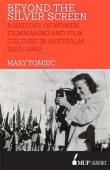 421913587222686586.jpg
421913587222686586.jpg
 Beyond the Silver Screen : A History of Women, Filmmaking and Film Culture in Australia 1920-1990
multi chapter work
Beyond the Silver Screen : A History of Women, Filmmaking and Film Culture in Australia 1920-1990
multi chapter work
 421913587222686586.jpg
421913587222686586.jpg
 Beyond the Silver Screen : A History of Women, Filmmaking and Film Culture in Australia 1920-1990
multi chapter work
Beyond the Silver Screen : A History of Women, Filmmaking and Film Culture in Australia 1920-1990
multi chapter work
'Beyond the Silver Screen tells the history of women’s engagement with filmmaking and film culture in twentieth-century Australia. In doing so, it explores an array of often hidden ways women in Australia have creatively worked with film. Beyond the Silver Screen examines film in a broad sense, considering feature filmmaking alongside government documentaries and political films. It also focuses on women’s work regulating films and supporting film culture through organising film societies and workshops to encourage female filmmakers. As such, it tells a new narrative of Australian film history.
'Beyond the Silver Screen reveals the variety of roles film has in Australian society. It presents film as a medium of creative and political expression, which women have engaged with in diverse ways throughout the twentieth century. Gender roles and gendered ideologies operating within society at large have influenced women’s opportunities to work with film and how their filmwork is recognised. Beyond the Silver Screen shows women’s sustained involvement with film is best understood as political and cultural action. ' (Publication summary)
'Mary Tomsic’s important and interesting book examines 70 years of women’s participation in Australian filmmaking and film culture. Rather than focusing on women as movie stars or movie fans, this book demonstrates the multiple dimensions of women’s ‘film-work’. A useful concept, film-work encompasses ‘work directly involved in the production of films’ and ‘work involved in supporting, controlling and valuing film in society’ (3). Women’s film-work in Australia spanned the production of feature, documentary, government, independent, and feminist films, distribution and exhibition activities, as well as social reform and educational efforts. To convey this breadth, Tomsic structures her book effectively, using her chapters as case studies to explore different dimensions of women’s film-work across time, beginning with early women filmmakers, such as the McDonagh sisters, and ending with film-school trained directors, such as Gillian Armstrong. Each chapter also contains biographical sketches of and interconnections among significant women film-workers, producing in the end a valuable collective biography alongside an appreciation of women’s contributions to film-work in Australia.' (Introduction)
'Mary Tomsic's selective survey of twentieth-century Australian film history makes a valuable addition to the growing catalogue of books about women's myriad and, of course, neglected contributions to film production and culture. Over the past few decades scholars have reconsidered both the roles women have played throughout film history as well as the questions raised by their rediscovery. Feminist scholars in particular are increasingly aware that in order to tell new stories about the impact and legacy of women's work, historiographers must also devise new questions and new methods.' (Introduction)
'In 1971, Australian filmmaker Joan Long wrote the script for a film about gentrification in the Sydney suburb of Paddington. At a screening in London, it was introduced by director Peter Weir. When asked who the scriptwriter was, Weir replied that she was a housewife, according to a friend of Long’s. Around this time, director Gillian Armstrong applied for a job at the ABC, only to be told that they didn’t interview women for jobs in camera, sound, or editing; she was asked to send in details of her typing speed.' (Introduction)
'Mary Tomsic's selective survey of twentieth-century Australian film history makes a valuable addition to the growing catalogue of books about women's myriad and, of course, neglected contributions to film production and culture. Over the past few decades scholars have reconsidered both the roles women have played throughout film history as well as the questions raised by their rediscovery. Feminist scholars in particular are increasingly aware that in order to tell new stories about the impact and legacy of women's work, historiographers must also devise new questions and new methods.' (Introduction)
'In 1971, Australian filmmaker Joan Long wrote the script for a film about gentrification in the Sydney suburb of Paddington. At a screening in London, it was introduced by director Peter Weir. When asked who the scriptwriter was, Weir replied that she was a housewife, according to a friend of Long’s. Around this time, director Gillian Armstrong applied for a job at the ABC, only to be told that they didn’t interview women for jobs in camera, sound, or editing; she was asked to send in details of her typing speed.' (Introduction)
'Mary Tomsic’s important and interesting book examines 70 years of women’s participation in Australian filmmaking and film culture. Rather than focusing on women as movie stars or movie fans, this book demonstrates the multiple dimensions of women’s ‘film-work’. A useful concept, film-work encompasses ‘work directly involved in the production of films’ and ‘work involved in supporting, controlling and valuing film in society’ (3). Women’s film-work in Australia spanned the production of feature, documentary, government, independent, and feminist films, distribution and exhibition activities, as well as social reform and educational efforts. To convey this breadth, Tomsic structures her book effectively, using her chapters as case studies to explore different dimensions of women’s film-work across time, beginning with early women filmmakers, such as the McDonagh sisters, and ending with film-school trained directors, such as Gillian Armstrong. Each chapter also contains biographical sketches of and interconnections among significant women film-workers, producing in the end a valuable collective biography alongside an appreciation of women’s contributions to film-work in Australia.' (Introduction)